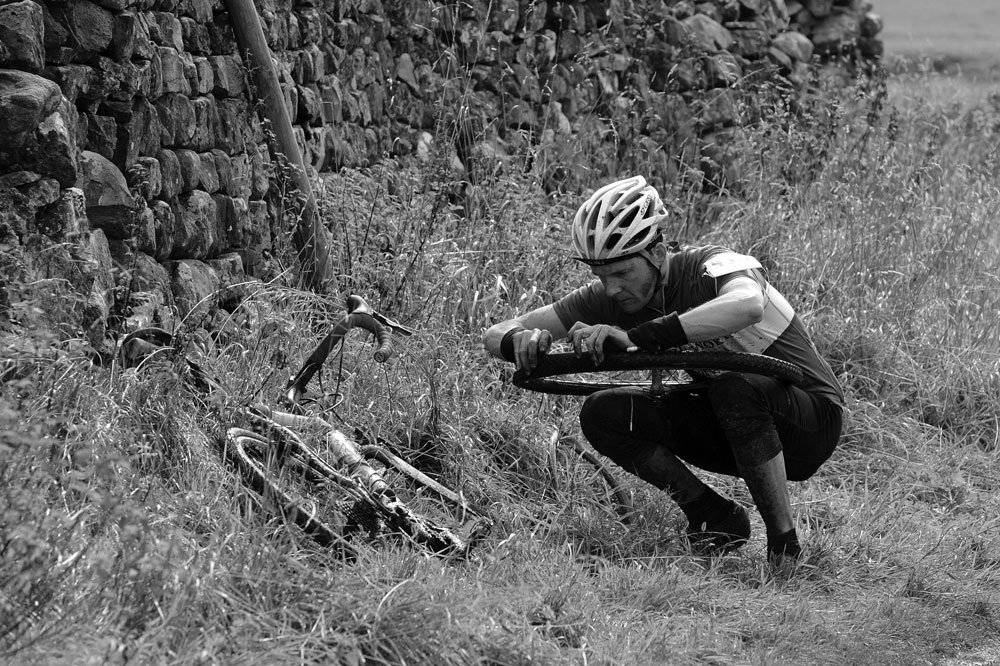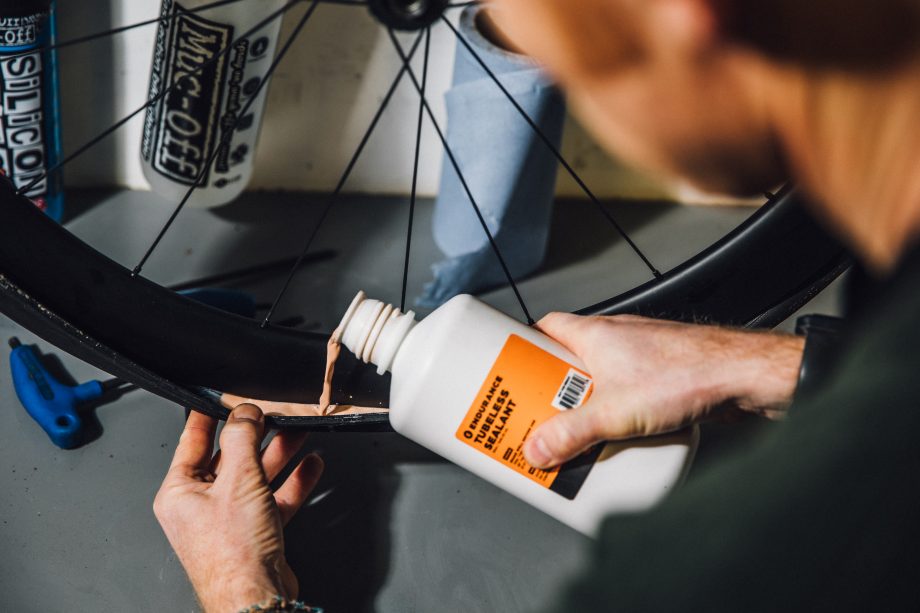Just put a tube in it: why tubeless wheel systems aren't ready for road bikes
And other issues the road market should address before fully adopting tubeless tech...


I would like to preface this rant comment with the statement that I am not a tubeless naysayer. Nor am I a member of a certain tribe of riders keen to teeter on 21mm tyres whilst vowing on the sanctity of rim brakes forevermore.
However, last night I had a tubeless nightmare. And I blame the bike industry, or, more specifically wheel, tyre and sealant manufacturers.
I've had many positive experiences with tubeless tires. There was the blissful winter spent aboard the GP5000 TL tyres without a single flat. Also in the ‘good experiences’ locker were those lovely Zipp tyres that popped on the matching hookless Zipp rim and inflated in less time than it would take to add a tube. Compatibility between two seemingly matching parts shouldn’t come as a surprise - but let us not dwell. Those were good tubeless experiences.
Last night was not a good experience. At the risk of being ridiculed for writing 1,000 words on what was, basically, just a puncture, let me tell you all about it.
The disaster began several days ago, with a shard of glass lodged in my front tyre. The offending weapon against inflation burrowed itself into the rubber in the first kilometre of my ride, sending sealant flying up the front forks of a box-fresh bike. No bother, I removed the material, spun the front wheel and re-inflated the tyre. All seemed well until I returned to the bike the following day to find the tyre soft and an ominous dribble of pink fluid sliding away from the scene of the glass injury and landing forlornly into a puddle of goo.
Keen to avoid further ride interruptions, and with ample stock of tyres, I selected a new pair. Sealant tippled into the waiting new rubber, bead satisfyingly pinged onto the rim, and inflation complete, the first hour passed without event.
And then, I heard it. Pshh. Glancing over my right shoulder, the sight that met my view was a reverse waterfall of pearlescent pink/purple fluid spewing from my newly fitted rear tyre. I spun the wheel, pumped as hard and as fast as I could and proceeded to endure 30 minutes of hopeful silence interspersed with loud Pssshhhhhh expulsions, a bit like the noises exiting the uncle everyone knows should avoid the sprouts at Christmas; each rude interruption was accompanied by the warm splash of a new gush of sealant hitting the back of my legs.
You may be wondering, at this point, if I am just the owner of copious amounts of the worlds worst tubeless sealant. No, my dear reader - for I used different liquids in both instances. I've not name-dropped brands here because I've had these experiences on assorted tyres using assorted sealants.
This experience is not particularly uncommon, it is not new-news that whilst extremely efficient on mountain bike, gravel bike and car tyres, sealant struggles to coagulate within skinny tyres at higher pressures (by which I mean, for clarification sake, over 50 psi, narrower than 32mm).
I know that brands are working on sealants better tailored to higher pressures - and I don't believe they'd do so if there was not an issue to address. If the sealant doesn't do its job, the tyre won't either.
Slipping out of 'disgruntled user' mode and back into 'journalist' gear, when I asked Surrey Hills Cycleworks bike shop owner, Dave Farmer, he told me: "No mechanics use road tubeless. I don't know any. They all rant about road tubeless. As a mountain biker, I've used tubeless since about 2000. But I've tried a host of modern tubeless road tyres and I only ever get 400 miles out of the rear tyre before the tyre slashes and the sealant won't seal.
"If I'm asking my customers to spend £60 on a tyre and they can't get more than 400 miles out of them, I feel like I'm taking the p*** out of my customers. If they put a tube in, they get 2,000 miles out of them before it's worn out.
"I've got four tubeless only wheels in my workshop right now where the customer is fed up with tubeless. They want to put inner tubes in their wheels, and I'm getting clarification from the brands as to whether or not that's allowed," he added.
A post shared by Bike Shop , Leatherhead Surrey (@surreyhillscycleworks)
A photo posted by on
Back to my ride. The sticky liquid bubbled away at the surface, occasionally ejecting itself in ferocious jets of pressure loss. No, I did not have with me a plug, but then Farmer doesn't reckon it would have helped.
"Using all the plugs that plug a hole works great on a mountain bike, but on a road bike, the pressure just pushes the plug out," he told me, the morning after the night before. Plug solutions vary, the Stans Dart has come up as a much better alternative since it creates a chemical reaction rather than just filling a gap.
Eventually, I decided to try to fix the problem by way of inserting a good old fashioned inner tube.
This method has been successful in the past. Except in this instance, the valve required a set of pliers to be removed. My dear reader, I did not have upon my person a set of portable pliers. You may ask why a tech editor would be so woefully unprepared, to which I would respond, “I have never, in over a decade of bike riding, needed to carry pliers in my saddlebag before." I don't intend to start now.
With no way of removing the valve to insert a tube, I was left with a sealant soaked rim and a pair of hands now attracting every blade of grass on the verge which I had made my temporary workshop. Because the tubeless-puncture-gods clearly have a sense of humour, said verge happened to be adjacent to the warm-up stretch for a local time trial, so I was kindly offered a tube and use of a track pump - both generous, neither useful - approximately once every 30 seconds.
Eventually, it was a C02 canister that got the tyre to a rideable state. The process involved quick application and a flying leap onto the bike to get rolling before more air could exit the pinprick hole (which, I might add, would have been sealed up in no time on a wide and burly gravel tyre). After a brief stop to administer a second dose of air, I arrived home with around 20 psi to spare.
Thinking of going tubeless?

"When customers tell me they want a tubeless set up, I ask them why, and if they know the manufacturers reason for making tubeless tyres. Usually, the customer wants fewer flats. But the manufacturer isn't focusing on that, they're making these tyres for better performane - rolls raster, grips better," says Farmer. Tubeless set-ups have been shown to give away fewer energy losses to rolling resistance (though latex tubes come pretty close, if not equal) - but if you're seeking fewer roadside rescue situations? It might not be the answer for you.
Were this incident an unfortunate, but isolated, incident, I would let it be. If I was trying to ride tyres pumped up hard enough to give The Rock a run for his money, I'd get it. But it was not and I am not. SRAM's tubeless calculator recommends I ride a 28mm tyre at 50 psi, and even at that pressure, I've found myself with unsealing sealant.
"Tubeless is great until it's not," Farmer told me.
"If the sealant doesn't seal, and a plug doesn't plug, you'll have to put a tube in. Once the valves been in there, and the sealant has coagulated around the valve, it's really hard to get them out."
"Then, honestly trying to get an inner tube into a tubeless-ready tyre with their really stiff bead, you usually end up pinching the tube, it's not a fix that works really," Farmer says. It is a fix that's worked for me in the recent past, but I've also had countless experiences of tyre fitting induced thumb RSI in recent years as tubeless ready tyres have become tougher at the bead.
Farmer is far from alone, when we asked owner of Velo-Tech Cheshire, mechanic Martin Girdwood said: "with narrower tubeless tyres you’ve got such a small surface area at such incredible pressures compared to a mountain bike one. From what I’ve been seeing, I’d recommend sticking with tubes for 25mm.”
A post shared by Brian Holm (@holm12.16)
A photo posted by on
When it works, tubeless riding is excellent. I’ve had many happy, consecutive months of riding without a single deflating moment. But I have also encountered several incidents where the sealant has failed to heal the site of penetration.
Tubeless technology is unquestionably advantageous when applied to mountain bikes, gravel bikes, hybrid bikes - and all manner of rolling stock commonly run below, say, 50 psi. On the road? I think some real work needs to be done on the stuff we put inside the tyres narrower than 32mm.
And please, if we could come up with some sort of rim and tyre compatibility code and a standard valve type whilst we’re at it, that would be nice, too.

Thank you for reading 20 articles this month* Join now for unlimited access
Enjoy your first month for just £1 / $1 / €1
*Read 5 free articles per month without a subscription

Join now for unlimited access
Try first month for just £1 / $1 / €1
Get The Leadout Newsletter
The latest race content, interviews, features, reviews and expert buying guides, direct to your inbox!
Michelle Arthurs-Brennan the Editor of Cycling Weekly website. An NCTJ qualified traditional journalist by trade, Michelle began her career working for local newspapers. She's worked within the cycling industry since 2012, and joined the Cycling Weekly team in 2017, having previously been Editor at Total Women's Cycling. Prior to welcoming her first daughter in 2022, Michelle raced on the road, track, and in time trials, and still rides as much as she can - albeit a fair proportion indoors, for now.
Michelle is on maternity leave from April 2025 until spring 2026.
-
 'I'll take a top 10, that's alright in the end' - Fred Wright finishes best of British at Paris-Roubaix
'I'll take a top 10, that's alright in the end' - Fred Wright finishes best of British at Paris-RoubaixBahrain-Victorious rider came back from a mechanical on the Arenberg to place ninth
By Adam Becket Published
-
 'This is the furthest ride I've actually ever done' - Matthew Brennan lights up Paris-Roubaix at 19 years old
'This is the furthest ride I've actually ever done' - Matthew Brennan lights up Paris-Roubaix at 19 years oldThe day's youngest rider reflects on 'killer' Monument debut
By Tom Davidson Published